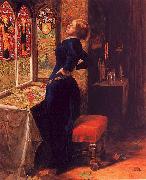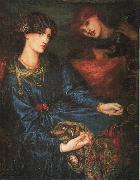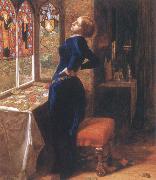
|
Sir John Everett Millais
|
|||
|
|
|||
| British 1829-1896 Sir John Everett Millais Galleries After his marriage, Millais began to paint in a broader style, which was condemned by Ruskin as "a catastrophe". It has been argued that this change of style resulted from Millais' need to increase his output to support his growing family. Unsympathetic critics such as William Morris accused him of "selling out" to achieve popularity and wealth. His admirers, in contrast, pointed to the artist's connections with Whistler and Albert Moore, and influence on John Singer Sargent. Millais himself argued that as he grew more confident as an artist, he could paint with greater boldness. In his article "Thoughts on our art of Today" (1888) he recommended Vel??zquez and Rembrandt as models for artists to follow. The Two Princes Edward and Richard in the Tower (1878) The Boyhood of Raleigh (1871)Paintings such as The Eve of St. Agnes and The Somnambulist clearly show an ongoing dialogue between the artist and Whistler, whose work Millais strongly supported. Other paintings of the late 1850s and 1860s can be interpreted as anticipating aspects of the Aesthetic Movement. Many deploy broad blocks of harmoniously arranged colour and are symbolic rather than narratival. Later works, from the 1870s onwards demonstrate Millais' reverence for old masters such as Joshua Reynolds and Vel??zquez. Many of these paintings were of an historical theme and were further examples of Millais' talent. Notable among these are The Two Princes Edward and Richard in the Tower (1878) depicting the Princes in the Tower, The Northwest Passage (1874) and the Boyhood of Raleigh (1871). Such paintings indicate Millais' interest in subjects connected to Britain's history and expanding empire. His last project was to be a painting depicting a white hunter lying dead in the African veldt, his body contemplated by two indifferent Africans. This fascination with wild and bleak locations is also evident in his many landscape paintings of this period, which usually depict difficult or dangerous terrain. The first of these, Chill October (1870) was painted in Perth, near his wife's family home. Many others were painted elsewhere in Perthshire, near Dunkeld and Birnam, where Millais rented grand houses each autumn in order to hunt and fish. Millais also achieved great popularity with his paintings of children, notably Bubbles (1886) ?C famous, or perhaps notorious, for being used in the advertising of Pears soap ?C and Cherry Ripe. | |||
|
|
|||
|
Mariana Sir John Everett Millais2.jpg Painting ID:: 2859 |
1851 | ||
|
|
|||
|
Dante Gabriel Rossetti
|
|||
|
|
|||
| English Pre-Raphaelite Painter, 1828-1882 Rossetti's first major paintings display some of the realist qualities of the early Pre-Raphaelite movement. His Girlhood of Mary, Virgin and Ecce Ancilla Domini both portray Mary as an emaciated and repressed teenage girl. His incomplete picture Found was his only major modern-life subject. It depicted a prostitute, lifted up from the street by a country-drover who recognises his old sweetheart. However, Rossetti increasingly preferred symbolic and mythological images to realistic ones. This was also true of his later poetry. Many of the ladies he portrayed have the image of idealized Botticelli's Venus, who was supposed to portray Simonetta Vespucci. Although he won support from the John Ruskin, criticism of his clubs caused him to withdraw from public exhibitions and turn to waterhum, which could be sold privately. In 1861, Rossetti published The Early Italian Poets, a set of English translations of Italian poetry including Dante Alighieri's La Vita Nuova. These, and Sir Thomas Malory's Morte d'Arthur, inspired his art in the 1850s. His visions of Arthurian romance and medieval design also inspired his new friends of this time, William Morris and Edward Burne-Jones. Rossetti also typically wrote sonnets for his pictures, such as "Astarte Syraica". As a designer, he worked with William Morris to produce images for stained glass and other decorative devices. Both these developments were precipitated by events in his private life, in particular by the death of his wife Elizabeth Siddal. She had taken an overdose of laudanum shortly after giving birth to a stillborn child. Rossetti became increasingly depressed, and buried the bulk of his unpublished poems in his wife's grave at Highgate Cemetery, though he would later have them exhumed. He idealised her image as Dante's Beatrice in a number of paintings, such as Beata Beatrix. These paintings were to be a major influence on the development of the European Symbolist movement. In these works, Rossetti's depiction of women became almost obsessively stylised. He tended to portray his new lover Fanny Cornforth as the epitome of physical eroticism, whilst another of his mistresses Jane Burden, the wife of his business partner William Morris, was glamorised as an ethereal goddess. | |||
|
|
|||
|
Mariana Dante Gabriel Rossetti40.jpg Painting ID:: 3615 |
1868-70 Aberdeen Art Gallery and Museum | ||
|
|
|||
|
Sir John Everett Millais
|
|||
|
|
|||
| British 1829-1896 Sir John Everett Millais Galleries After his marriage, Millais began to paint in a broader style, which was condemned by Ruskin as "a catastrophe". It has been argued that this change of style resulted from Millais' need to increase his output to support his growing family. Unsympathetic critics such as William Morris accused him of "selling out" to achieve popularity and wealth. His admirers, in contrast, pointed to the artist's connections with Whistler and Albert Moore, and influence on John Singer Sargent. Millais himself argued that as he grew more confident as an artist, he could paint with greater boldness. In his article "Thoughts on our art of Today" (1888) he recommended Vel??zquez and Rembrandt as models for artists to follow. The Two Princes Edward and Richard in the Tower (1878) The Boyhood of Raleigh (1871)Paintings such as The Eve of St. Agnes and The Somnambulist clearly show an ongoing dialogue between the artist and Whistler, whose work Millais strongly supported. Other paintings of the late 1850s and 1860s can be interpreted as anticipating aspects of the Aesthetic Movement. Many deploy broad blocks of harmoniously arranged colour and are symbolic rather than narratival. Later works, from the 1870s onwards demonstrate Millais' reverence for old masters such as Joshua Reynolds and Vel??zquez. Many of these paintings were of an historical theme and were further examples of Millais' talent. Notable among these are The Two Princes Edward and Richard in the Tower (1878) depicting the Princes in the Tower, The Northwest Passage (1874) and the Boyhood of Raleigh (1871). Such paintings indicate Millais' interest in subjects connected to Britain's history and expanding empire. His last project was to be a painting depicting a white hunter lying dead in the African veldt, his body contemplated by two indifferent Africans. This fascination with wild and bleak locations is also evident in his many landscape paintings of this period, which usually depict difficult or dangerous terrain. The first of these, Chill October (1870) was painted in Perth, near his wife's family home. Many others were painted elsewhere in Perthshire, near Dunkeld and Birnam, where Millais rented grand houses each autumn in order to hunt and fish. Millais also achieved great popularity with his paintings of children, notably Bubbles (1886) ?C famous, or perhaps notorious, for being used in the advertising of Pears soap ?C and Cherry Ripe. | |||
|
|
|||
|
Mariana new16/Sir John Everett Millais-585486.jpg Painting ID:: 40706 |
mk156 1851 Oil on canvas 59.7x49.5cm | ||
|
|
|||
|
Also Buy::. For Following Paintings / Artists / Products, Please Use Our Search Online: |










